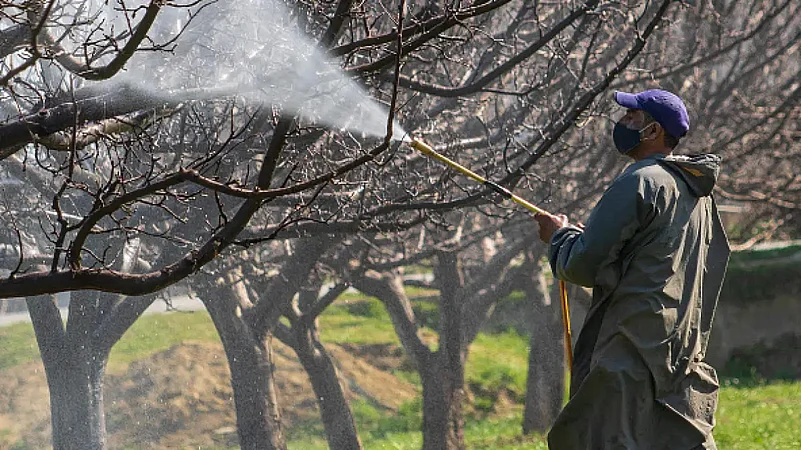In 2019, the Food and Agriculture Organization (FAO) published an alarming report titled The State of the World’s Biodiversity for Food and Agriculture which said that the loss of biodiversity is driving the global food system. Across the world, it said, large areas of monoculture—growing a single crop—are replacing biodiverse agricultural landscapes. It also said that just nine plant species form two-thirds of total crop production.
The Green Revolution that radically changed Indian food production and helped maintain food security by introducing High Yield Variety (HYV) seeds, tractors and fertilisers, also introduced multiple new challenges, including deteriorating land quality, chemical infested food, and lower productivity of the land.
Experts believe it is because of the “cheaper food paradigm”, the production of more and more food at cheaper rates, which countries across the world including India followed. The “intensified agricultural production”—with heavy reliance on fertiliser, pesticides, energy and water—degraded soil fertility and ecosystems, and also reduced production capacity, which, in turn, brought farmers under debt.
Devinder Sharma, an expert on Indian agriculture, says, “We are producing surplus food. The greatest challenge is now, how to stop wastage. So, we don’t have to focus much on how much we produce. Instead, we should be focusing on producing healthy food—free of harmful pesticides and insecticides. The idea that we should have organic food, and avoid pesticide infested food and that should drive the production and demand.”
But is it easy? There are over 300 pesticides in use in India, as per official data. And the government is planning to ban 27 harmful pesticides as part of phasing out 66 contentious pesticides. Still, there are over 24 pesticides in use, classified as harmful, including Sulphur (fungicide), Endosulfan (insecticide), Mancozeb (fungicide), Phorate (insecticide). These are, in fact, among the most used pesticides in India.
Besides, banning pesticides has its own set of challenges. First is the overdependence of farmers on pesticides to increase productivity, as land fertility is consistently deteriorating. And second, resistance from industries. Due to erratic monsoon and rising temperature due to climate change, pest attacks are rising. The locust attack last year was the biggest example of how pests are growing, which in turn is forcing farmers to control pests by using harmful pesticides. A senior scientist at the Division of Entomology, Indian Agriculture Research Institute (IARI), says, “Insects are cold-blooded organisms, and they love rain-less humid days.”
Current agricultural practices are creating a vicious cycle, as the agriculture sector is the second-largest greenhouse gas emitter, which is happening due to unsustainable agricultural practices—increasing use of pesticides and insecticides causing soil disturbance. This affects crop yield and forces farmers to use more and more pesticides.

India has a huge domestic market for pesticides and insecticides. As per the 2020 CropLife India, a conglomeration of 15 companies engaged in crop protection, the domestic market size of crop protection products in India is estimated at Rs 232.2 billion by sales. In 2020, when a draft notification to ban 27 pesticides was released, many industrialists showed concern. Pradip Dave, the President of Pesticides Manufacturers & Formulators Association of India (PMFAI) told media that the decision would affect the Atma Nirbhar Bharat campaign and reduce India’s export by 50 per cent. But civil societies have been demanding a ban on harmful pesticides for the last few years.
Therefore, in 2013, the government appointed a committee to review 66 harmful pesticides under Anupam Verma, a retired professor from the Indian Agriculture Research Institute (IARI). Its recommendation included ban on 19 pesticides in a phased manner in 2015, and reviewing 27 other pesticides—which are now being considered for the ban. The government later banned 18 pesticides, including seven Class-I pesticides (extremely hazardous to use).
These are good decisions. Our food should be pesticide-free. Consumers are also being aware of the harmful effects of pesticide infested food, this will bring change,” Devinder Sharma says. However, the biggest challenge is to create awareness and also the infrastructure for farmers to adapt themselves to the challenges of climate change and also produce organic food.
Punjab and Haryana, known as torch-bearers of the Green Revolution in India, offered only a few solutions to ensure food security in India. Several banned pesticides are still in use in both states. The domestic market for pesticides has boomed. It is resulting in harmful effects, including rising cases of cancer. Several studies confirm that class 1 pesticides are carcinogenic.
Various studies are suggesting that monoculture is also harming food production, as many traditional varieties of plants, including pulses rich in nutrients, are increasingly diminishing.
In 2015, over 811 cultivated plants and 902 of their wild relatives were documented. But they are increasingly under threat of extinction.
India is the second-largest producer of wheat and rice and groundnuts and first in Jute, which is good but, More than 85% smallholders mostly produce rice, wheat, pulses, spices, vegetables and other cereals through monocropping. Which made farmers more vulnerable to challenges related to climate change.
Many practitioners and experts believe that there is a need to make farming climate change-adaptive. Kumar Neeraj, the co-founder of 'Khetee'—a Bihar-based non-profit promoting benefits of agroforestry, says, “We have to provide bio-nutrients to the land instead of chemicals.”
Neeraj finds that there is a huge challenge in creating awareness among farmers. “Farmers are resistant to new changes as agriculture is risky. Therefore, we need to create various models of sustainable farming practices that farmers can easily learn, like agro-forestry.”
















